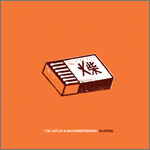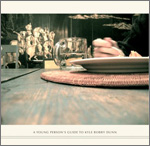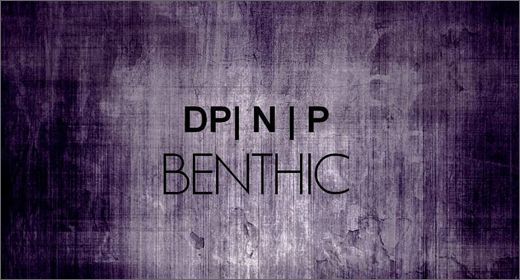(June 2010) THE turn of the years’ final digits from 09 to 10 have seen no relenting in the swell from Nottingham’s finest ambient drone label, Low Point. Main man Gareth Hardwick has continued with an enhanced release schedule, with three CD’s of variable approachability and outcome from Tim Catlin & Machinefabriek, Spartak, and Kyle Bobby Dunn.

Kicking off with Glisten, we find a distillation of the results of the first communing of Melbourne-based experimental guitarist, Tim Catlin, with uber-productive Rotterdam axescapeist, Machinefabriek. Rutger Zuydervelt seemingly stumbled upon Catlin’s previous album, Radio Ghosts, while idly researching prepared guitar, and the idiosyncratic cut of the Aussie’s jib beguiled him sufficiently to prompt him to explore communion. Catlin made initial recordings drawing on a wide range of guitar stylings and tweakings, customized and abused effects through to common-or-garden picking. Zuydervelt picked up his deliveries and sprinkled them with his signature micro-sonic fairy dust – sundry whirrs, clicks, and fizzes. With both having a keen eye for the micro- of sound, Glisten proves an engrossing listen: unravelling resonances, drones and accidental harmonics. There’s also a pronounced element of indeterminacy, with prepared process allowed to have its way. But while visibly cut from the cloth of experimental process methodology, Glisten never falls into the traps of chaotic indeterminacy or simplistic improv. Timbres tend towards the purer and cleaner end of the sonic continuum, with gruzzier overdrive sparingly purposively deployed (see esp. “Haul”). And while structures and sound sometimes sail close to Machinefabriek’s already widely promulgated signature, more articulation from Catlin’s voice is perceptible on certain pieces that differ markedly from Zuydervelt’s solo work, departing from a processing-heavy template, resisting default droning, letting instrumental source retain more than the vestiges of its true colours. Glisten‘s somewhat lowlight highlights include rippling oscillations of “Flutter,” the undulant drones and bell tones of “Ghostbox” and “Glisten 1”, and, most dramatically, “Haul”‘s slippage from dreamy drift to steely tsunami. “Glisten 2” may be the most satisfyingly Machinefabriek-ated of all, placing the listener as if at the centre of a slow flow of molten metals.

On the second of this experimental trio, Verona, has Spartak – Australian pair Shoeb Ahmad (guitar, electronics) and Evan Dorrian (drums, percussion) – seemingly seeking to emancipate themselves from the constraints of single instruments and expand their sound palette. Alas, the excited tone of the press blurb and its ambitious implied mission statement fails to carry through to concomitant arousal for the ears. The pair adopt what is referred to as an anything goes approach to their sessions, co-opting no-input mixing board, 4-track manipulation and analogue pedal processing (Ahmad), and liberal spraying with treated percussion, junk and field recordings (Dorrian) for a composite of high concept sound art and cathartic rock abandon (it says here). What goes, more than anything, turns out to be a fairly formless farrago of prepared guitars, field recordings, and radio extracts, slivers of errant melody buffeted by a rattle and din of percussion and audio flotsam. The textures of “Morning Prayer” with its shimmering prepared guitar offer a misleadingly auspicious opener. But the tone is unset, as things fall apart into fiddle, paradiddle and a flurry of patter and pluckery as “The Waves To The Rails” loops the life out of the remains of “Morning Prayer,” threading glitch squalls and spoken word babble through them. The initial sonorous light further palls, as an unkindness of drum clatter batters away the last vestiges of interest; other externalia, e.g. Joseph McKee’s “tape ghost voices” on “Sleepstalker” and Lucrecia Perez’s low-rent Lisa Gerrard “angel voices” on “Second-Half Clouded” fail to weigh in with the intended evocative cargo. Throughout Verona a spirit of improv is alluded to, but, rather than galvanic, casts an air of aimless fidgeting over proceedings; electronic treatments operate largely as a distractive veneer, failing to cloak a paucity of coherence and depth in a summoning of half-formed ideas that remains an assemblage of unfulfilled and unfulfilling fragments.

Best of the bunch is A Young Person’s Guide To Kyle Bobby Dunn, the eponymous NY-based sonician’s bid for a part in the play of chronostatic scenes in the ambient-drone/modern classical arthouse. Kyle Bobby Dunn is one of a new wave of soundsmiths re-contextualising classical instrumentation (strings, brass and piano) in post-digital frames – raw material, musician-made, remade and and remodelled in software. He may associate himself, through the tag “21st century composer,” with a certain late-classical lineage – perhaps the Pärts and the Feldmans of this world, but the clearer alignment for this listener is with Eno through Stars of the Lid to Celer, Dunn’s music being similarly predicated on slowcore turns – of swell to relent and back again, of delicate orchestral figures bleeding through process interventions into slow-dissolve fields, delicately mis-treated tones crumbling into strange harmonies, time-lapse shift from clear-light to smudge-smeared. Textures vary subtly but crucially internally, languorous recursions, spatial, tranquil, elegiac – the usual suspect epithets indicating a shared lexis for a similarly immersive effect from treatments of guitar, strings and brass. The first disc is largely formed of tracks from last year’s d/l-only album Fervency, newly CD-rendered, a second disc of contemporaneous unreleased material the main event for the already Dunn inducted. Some sights along the way: “Grab (And Its Lost Legacies),” a 11-minute gaze at an overtone-heavy brass-bound deep frieze, “Empty Gazing,” more varied with more fulsome sensations of tone, like a Biosphere-Budd dream team; the delay-doused pianos-in-the-mist of “Last Minute Jest,” or “Promenade,” its instrumental forces summoned to swell into keening highs, as from the tonemass individual voices emerge then retreat. On the elegiac “Bonaventure’s Finest Hour” brass and strings are left almost naked, only scarce suggestive interventions hinting at something akin to Scelsci’s Third Dimension. A survey of what’s been Dunn (Music For Medication (2007), Six Cognitive Works (2007), Fragments & Compositions (2008)) show him to have been mining the same seam for some years, and his ambit indeed remains in a similar lugubrious zone of long slow drawn out gesture. But A Young Person’s Guide to… feels like a fulfilment, with less stills, more motion, high-end questing extending further down to low-end shake-the-room boom (see, e.g., “The Nightjar”). Horns and strings SotL-y unfurl into Celer-y aethers with Enovian ambiguity, binaries bleeding – picturesque blankness, romantic remotion, focused drowse, distracted rapture. The high point of this Low Point spotlight.
All releases above are out now on Low Point.
















![Pole :: Tempus Remixes (Mute) — [concise]](https://igloomag.com/wp/wp-content/uploads/2025/04/pole-tempus-remixes_feat-75x75.jpg)






![Hasbeen :: Bunker Symphonies II (Clean Error) — [concise]](https://igloomag.com/wp/wp-content/uploads/2025/04/hasbeen-bunker-symphonies-ii_feat-75x75.jpg)
